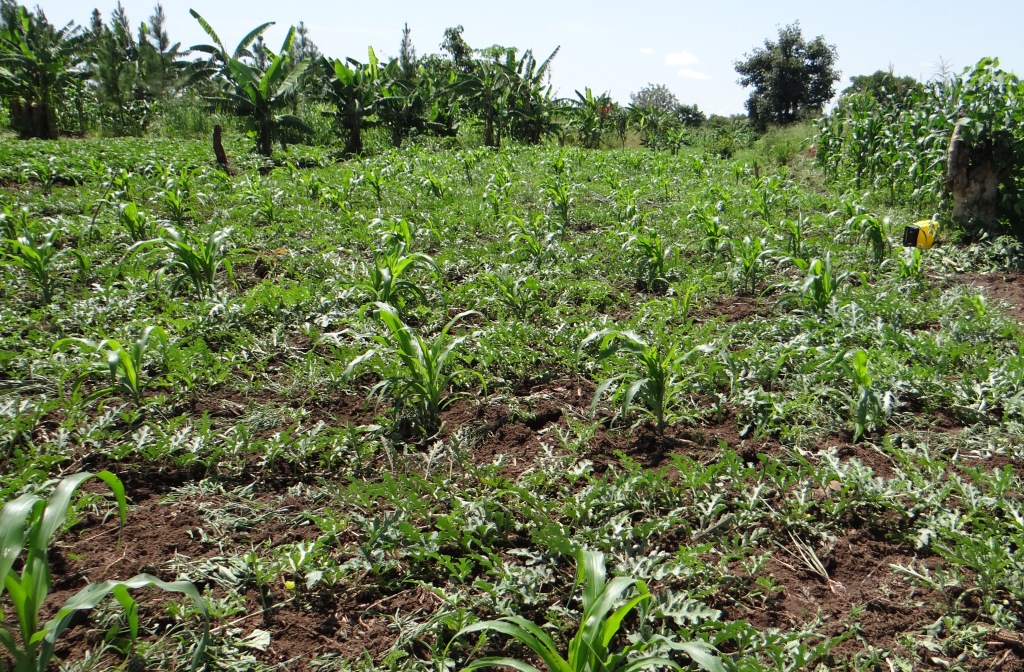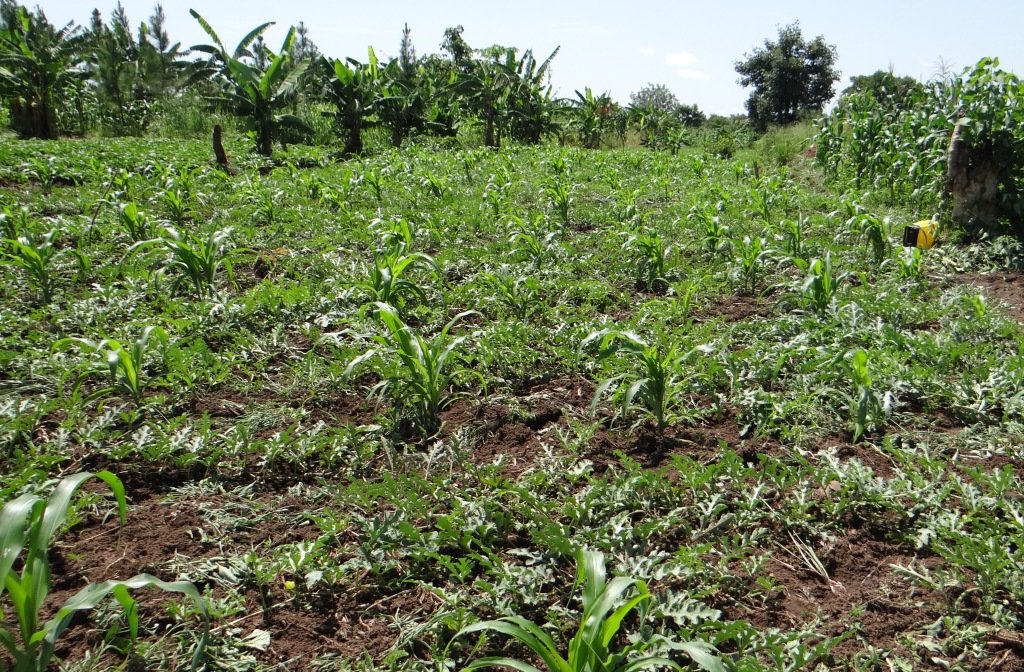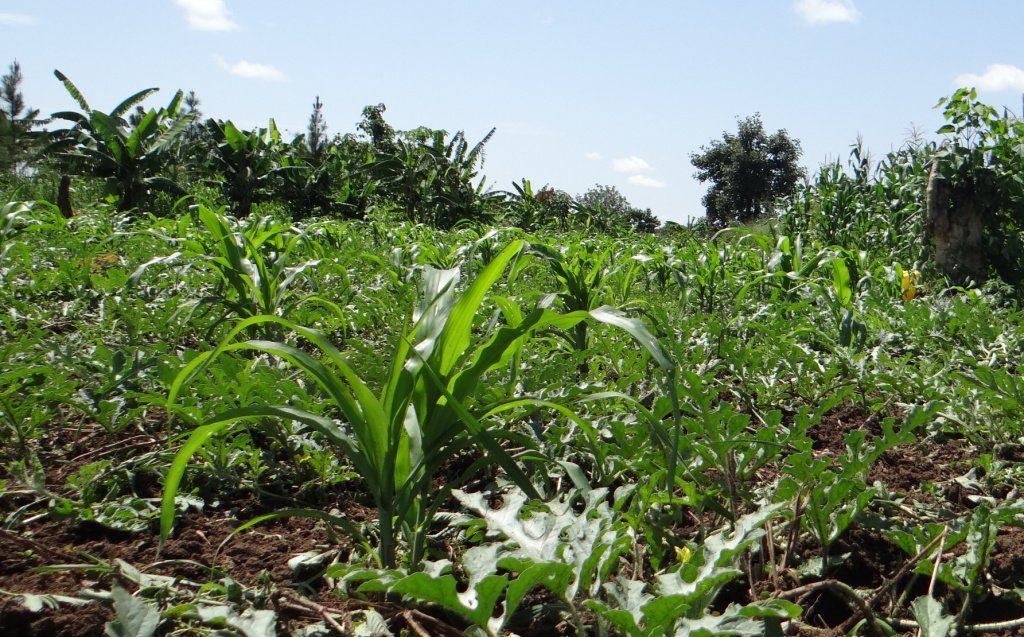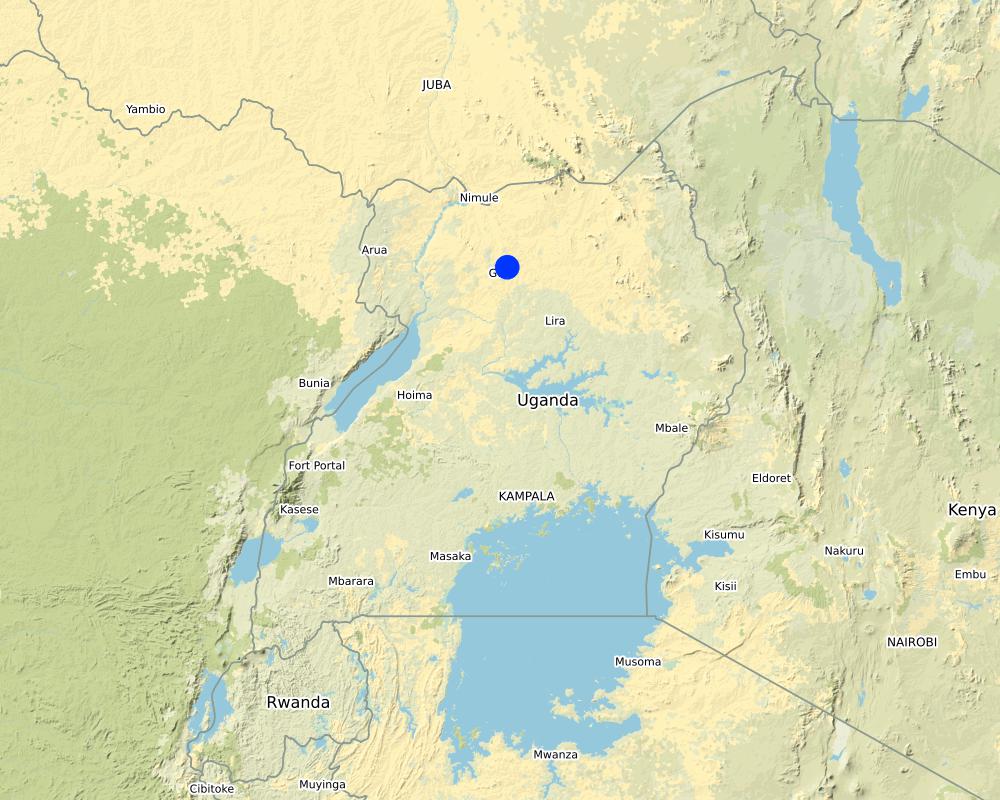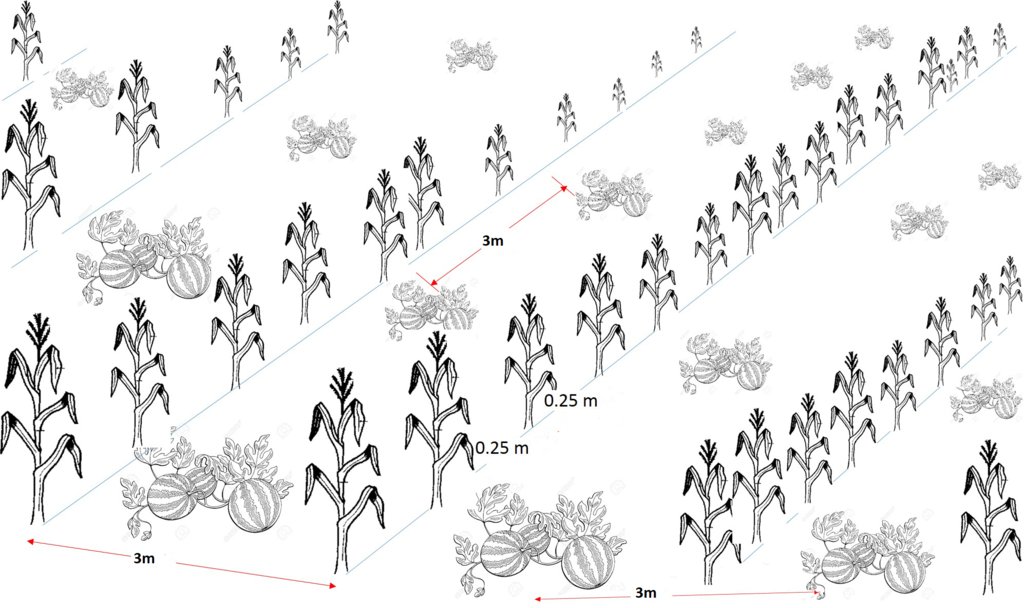Optimizing Land-Use Through Maize-Watermelon Intercropping [乌干达]
- 创建:
- 更新:
- 编制者: Bernard Fungo
- 编辑者: JOY TUKAHIRWA, Kamugisha Rick Nelson, betty adoch, Sunday Balla Amale
- 审查者: Udo Höggel
Anywagi ma kirubu ki water mellon
technologies_2872 - 乌干达
查看章节
全部展开 全部收起1. 一般信息
1.2 参与该技术评估和文件编制的资源人员和机构的联系方式
关键资源人
土地使用者:
Ojok Robin
Ryemocan PE
乌干达
1.3 关于使用通过WOCAT记录的数据的条件
编制者和关键资源人员接受有关使用通过WOCAT记录数据的条件。:
是
1.4 所述技术的可持续性声明
这里所描述的技术在土地退化方面是否存在问题,导致无法被认为是一种可持续的土地管理技术?:
否
2. SLM技术的说明
2.1 技术简介
技术定义:
Intercropping of maize with watermelon as a land optimization strategy
2.2 技术的详细说明
说明:
Traditionally, maize has been inter-cropped with other legumes such as common beans or soy bean. Intercropping of maize with water melon is used where the availability of land is limited in order to utilize optimally the available land. Watermelon has emerged as a high-value crop that can replace traditional companion crops in maize cultivations.
The technology is applied by planting maize of 0.25 meters within the rows and 1.0 meters between rows. Watermelon is planted at 1.0 meters meter between individual watermeleon plants. Sugar Baby, the watermelon variety grown in the areas, takes 120 days to mature. It produces melons with bright red flesh. This means that both maize and the water melon are harvested around the same time.
Watermelons like loamy, fertile, well-drained soil. Using a hoe, form mounds of earth (hills) to plant seeds in. Place 3 or 4 holes into the soil with a tool or your finger, about 2.5 cm deep. Place 1 to 4 seeds in each hole, then rake the soil flat over the top of the seeds, and lightly press the soil to pack it sufficiently to keep the moisture from quickly evaporating around the seed. Plant the seed directly into the ground. Keep the soil moist (50-60% moisture content) around the seeds during the germination period, water close enough so that the water reaches the small roots which are in the process of forming. When the seedlings grow, thin them down to the two strongest, to give the strong one room to grow. You should water at least once daily. Mulching soil under the vines helps suppress weeds and slows moisture evaporation.
The major limitation for which farmers detest this technology is that both maize and water melon take a lot of nutrients from the soil that need to be replaced periodically. Since water melon, unlike beans and soy bean, requires spraying, the profitability of this technology may be reduced by these input costs. Furthermore, there are several varieties of water melon that may perform differently in different soils and also have different preferences by consumers. So, there is need to evaluate the market potential of this technology.
Major benefits are increased income, employment, an additional food source, the minimisation of production risks and reduction of production costs by having many fields. The technology increases resilience and income security. Watermelons provide soil cover while maize provides shade to the melons.
2.3 技术照片
2.4 技术视频
日期:
24/5/2017
位置:
Gulu District
摄影师的名字:
Isa Aliga
2.5 已应用该技术的、本评估所涵盖的国家/地区/地点
国家:
乌干达
区域/州/省:
Northern
Map
×2.6 实施日期
注明实施年份:
2015
2.7 技术介绍
详细说明该技术是如何引入的:
- 通过土地使用者的创新
3. SLM技术的分类
3.1 该技术的主要目的
- 改良生产
- 降低灾害风险
- 适应气候变化/极端天气及其影响
- 创造有益的经济影响
- 创造有益的社会影响
3.2 应用该技术的当前土地利用类型

农田
- 一年一作
主要农作物(经济作物及粮食作物):
Maize, watermelon, beans
3.3 有关土地利用的更多信息
该技术所应用土地的供水:
- 雨养
每年的生长季节数:
- 2
3.4 该技术所属的SLM组
- 轮作制度(轮作、休耕、轮垦)
- 改良的地面/植被覆盖
- 最小的土壤扰动
3.5 技术传播
具体说明该技术的分布:
- 均匀地分布在一个区域
如果该技术均匀地分布在一个区域上,请注明覆盖的大致区域。:
- < 0.1 平方千米(10 公顷)
3.6 包含该技术的可持续土地管理措施

农艺措施
- A1:植被和土壤覆盖层
- A5:种子管理,改良品种

管理措施
- M2:改变管理/强度级别
- M5:物种组成的控制/变化
3.7 该技术强调的主要土地退化类型

化学性土壤退化
- Cn:肥力下降和有机质含量下降(非侵蚀所致)

其它
注释:
Response to crop potential failure due to increased drought
3.8 防止、减少或恢复土地退化
具体数量名该技术与土地退化有关的目标:
- 适应土地退化
4. 技术规范、实施活动、投入和成本
4.1 该技术的技术图纸
4.2 技术规范/技术图纸说明
Spacing between maize rows is 1.0 meter. The spacing within rows of maize is 0.25 meter.
Watermelons are planted at a spacing of 3m between rows and 3m within rows i.e. 3m by 3m.
Planting for both crops is done by direct sowing at the start of the rainy season.
Mulching and is done to reduce the need for weeding and to conserve soil moisture.
Spraying of watermelon against fungal infection is done (3 times). The first time one month after planting, the second time when the plants flower and the third time, when the fruits are fully formed.
Both crops are harvested after 3-4 months.
4.3 有关投入和成本计算的一般信息
具体说明成本和投入是如何计算的:
- 每个技术单元
指定单位:
Per technology unit
指定体积、长度等(如果相关):
Acre
其它/国家货币(具体说明):
Uganda Shillings
注明美元与当地货币的汇率(如相关):1美元=:
3500.0
注明雇用劳工的每日平均工资成本:
5000
4.4 技术建立活动
| 活动 | 措施类型 | 时间 | |
|---|---|---|---|
| 1. | Clearing of land | 管理 | Every season |
| 2. | Pitting and sawing of seed | 农业学的 | Every season |
| 3. | Mulching | 农业学的 | Every season |
| 4. | Spraying of water melon against fungal diseases | 农业学的 | Three times every season |
| 5. | Harvesting | 农业学的 | End of cropping season |
| 6. | Marketing | 管理 | Every end of cropping season |
4.5 技术建立所需要的费用和投入
| 对投入进行具体说明 | 单位 | 数量 | 单位成本 | 每项投入的总成本 | 土地使用者承担的成本% | |
|---|---|---|---|---|---|---|
| 劳动力 | Land preparation | Acre | 1.0 | 150000.0 | 150000.0 | 100.0 |
| 劳动力 | Pitting and sawing | Acre | 1.0 | 100000.0 | 100000.0 | 100.0 |
| 劳动力 | Mulching | Acre | 1.0 | 200000.0 | 200000.0 | 100.0 |
| 劳动力 | Spraying | Acre | 1.0 | 100000.0 | 100000.0 | 100.0 |
| 设备 | HandHoe for digging | 1 | 4.0 | 5000.0 | 20000.0 | 100.0 |
| 植物材料 | Seeds - watermelon | kg | 2.0 | 100000.0 | 200000.0 | 50.0 |
| 植物材料 | Seeds - maize | kg | 10.0 | 5000.0 | 50000.0 | 50.0 |
| 肥料和杀菌剂 | NPK | kg | 100.0 | 2000.0 | 200000.0 | 20.0 |
| 肥料和杀菌剂 | Urea | kg | 100.0 | 2000.0 | 200000.0 | 20.0 |
| 肥料和杀菌剂 | Fungicides | Liters | 15.0 | 20000.0 | 300000.0 | 20.0 |
| 肥料和杀菌剂 | Knapsack sprayer | Piece | 1.0 | 200000.0 | 200000.0 | 50.0 |
| 施工材料 | Mulching material | Bundles | 50.0 | 5000.0 | 250000.0 | 100.0 |
| 技术建立所需总成本 | 1970000.0 | |||||
如果土地使用者负担的费用少于100%,请注明由谁负担其余费用:
The supporting organisation subsidized the cost of seeds, fertilizer and biocides.
4.6 维护/经常性活动
| 活动 | 措施类型 | 时间/频率 | |
|---|---|---|---|
| 1. | Planting | 农业学的 | Every season |
| 2. | Mulching | 农业学的 | Every season |
| 3. | Spraying | 农业学的 | Three times a season |
4.7 维护/经常性活动所需要的费用和投入(每年)
| 对投入进行具体说明 | 单位 | 数量 | 单位成本 | 每项投入的总成本 | 土地使用者承担的成本% | |
|---|---|---|---|---|---|---|
| 劳动力 | Planting | Acre | 1.0 | 150000.0 | 150000.0 | 100.0 |
| 劳动力 | Mulching | Acre | 1.0 | 200000.0 | 200000.0 | 100.0 |
| 劳动力 | Spraying | Acre | 1.0 | 100000.0 | 100000.0 | 100.0 |
| 植物材料 | Seeds - Water melon | kg | 2.0 | 100000.0 | 200000.0 | 50.0 |
| 植物材料 | Seeds - Maize | kg | 10.0 | 5000.0 | 50000.0 | 50.0 |
| 肥料和杀菌剂 | NPK | kg | 100.0 | 2000.0 | 200000.0 | 20.0 |
| 肥料和杀菌剂 | Urea | kg | 100.0 | 2000.0 | 200000.0 | 20.0 |
| 肥料和杀菌剂 | Fungicides | Liters | 10.0 | 20000.0 | 200000.0 | 20.0 |
| 技术维护所需总成本 | 1300000.0 | |||||
4.8 影响成本的最重要因素
描述影响成本的最决定性因素:
Cost of seeds, fertilizer and spraying are the items mainly affecting costs
5. 自然和人文环境
5.1 气候
年降雨量
- < 250毫米
- 251-500毫米
- 501-750毫米
- 751-1,000毫米
- 1,001-1,500毫米
- 1,501-2,000毫米
- 2,001-3,000毫米
- 3,001-4,000毫米
- > 4,000毫米
农业气候带
- 半湿润
5.2 地形
平均坡度:
- 水平(0-2%)
- 缓降(3-5%)
- 平缓(6-10%)
- 滚坡(11-15%)
- 崎岖(16-30%)
- 陡峭(31-60%)
- 非常陡峭(>60%)
地形:
- 高原/平原
- 山脊
- 山坡
- 山地斜坡
- 麓坡
- 谷底
垂直分布带:
- 0-100 m a.s.l.
- 101-500 m a.s.l.
- 501-1,000 m a.s.l.
- 1,001-1,500 m a.s.l.
- 1,501-2,000 m a.s.l.
- 2,001-2,500 m a.s.l.
- 2,501-3,000 m a.s.l.
- 3,001-4,000 m a.s.l.
- > 4,000 m a.s.l.
说明该技术是否专门应用于:
- 不相关
5.3 土壤
平均土层深度:
- 非常浅(0-20厘米)
- 浅(21-50厘米)
- 中等深度(51-80厘米)
- 深(81-120厘米)
- 非常深(> 120厘米)
土壤质地(表土):
- 中粒(壤土、粉土)
土壤质地(地表以下> 20厘米):
- 中粒(壤土、粉土)
表土有机质:
- 中(1-3%)
5.4 水资源可用性和质量
地下水位表:
5-50米
地表水的可用性:
中等
水质(未处理):
仅供农业使用(灌溉)
水的盐度有问题吗?:
否
该区域正在发生洪水吗?:
否
5.5 生物多样性
物种多样性:
- 中等
栖息地多样性:
- 中等
5.6 应用该技术的土地使用者的特征
定栖或游牧:
- 定栖的
生产系统的市场定位:
- 生计(自给)
非农收入:
- 收入的10-50%
相对财富水平:
- 平均水平
个人或集体:
- 个人/家庭
机械化水平:
- 手工作业
性别:
- 男人
土地使用者的年龄:
- 青年人
5.7 应用该技术的土地使用者拥有或租用的平均土地面积
- < 0.5 公顷
- 0.5-1 公顷
- 1-2 公顷
- 2-5公顷
- 5-15公顷
- 15-50公顷
- 50-100公顷
- 100-500公顷
- 500-1,000公顷
- 1,000-10,000公顷
- > 10,000公顷
这被认为是小规模、中规模还是大规模的(参照当地实际情况)?:
- 中等规模的
5.8 土地所有权、土地使用权和水使用权
土地所有权:
- 个人,未命名
土地使用权:
- 个人
用水权:
- 个人
5.9 进入服务和基础设施的通道
健康:
- 贫瘠
- 适度的
- 好
教育:
- 贫瘠
- 适度的
- 好
技术援助:
- 贫瘠
- 适度的
- 好
就业(例如非农):
- 贫瘠
- 适度的
- 好
市场:
- 贫瘠
- 适度的
- 好
能源:
- 贫瘠
- 适度的
- 好
道路和交通:
- 贫瘠
- 适度的
- 好
饮用水和卫生设施:
- 贫瘠
- 适度的
- 好
金融服务:
- 贫瘠
- 适度的
- 好
6. 影响和结论性说明
6.1 该技术的现场影响
社会经济效应
生产
作物生产
生产故障风险
产品多样性
土地管理
生态影响
减少气候和灾害风险
干旱影响
6.2 该技术的场外影响已经显现
有关影响评估的意见:
No obvious off-site impacts are observed
6.3 技术对渐变气候以及与气候相关的极端情况/灾害的暴露和敏感性(土地使用者认为的极端情况/灾害)
气候有关的极端情况(灾害)
气候灾害
| 该技术是如何应对的? | |
|---|---|
| 干旱 | 适度 |
6.4 成本效益分析
技术收益与技术建立成本相比如何(从土地使用者的角度看)?
短期回报:
非常积极
长期回报:
非常积极
技术收益与技术维护成本/经常性成本相比如何(从土地使用者的角度看)?
短期回报:
非常积极
长期回报:
非常积极
6.5 技术采用
- 1-10%
在所有采用这项技术的人当中,有多少人是自发地采用该技术,即未获得任何物质奖励/付款?:
- 10-50%
6.6 适应
最近是否对该技术进行了修改以适应不断变化的条件?:
否
6.7 该技术的优点/长处/机会
| 土地使用者眼中的长处/优势/机会 |
|---|
| Increase diversification in production |
| Improved soil conservation by mulching and fertilizer application |
6.8 技术的弱点/缺点/风险及其克服方法
| 土地使用者认为的弱点/缺点/风险 | 如何克服它们? |
|---|---|
| Nutrient mining by both crops | Application of adequate levels of fertilizer to replenish soil nutrient stocks |
| Low labour availability due to rural-urban migration by the youth | Mechanize farming practices |
7. 参考和链接
7.1 信息的方法/来源
- 实地考察、实地调查
1
- 与土地使用者的访谈
1
7.2 参考可用出版物
标题、作者、年份、ISBN:
N/a
7.3 链接到网络上可用的相关信息
标题/说明:
N/a
链接和模块
全部展开 全部收起链接
无链接
模块
无模块


